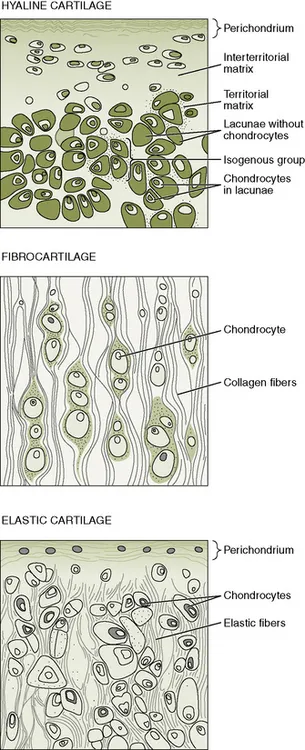Cartilage
Cartilage, a type of connective tissue, can tolerate mechanical stress and acts as a supporting structure in the body. It provides a mechanism for shock absorption, acts as a sliding surface for the joints, and plays a role in the development and growth of bone. During fetal development, a cartilage model is laid down from which the long bones of the body will develop. The ends of immature long bones and some sites of muscular attachment also contain cartilage plates, which are sites of bone growth.
Three types of cartilage exist, each meeting different functional needs (Figure 6-1). Hyaline cartilage is the most abundant and rigid. It is found at the articular surfaces of joints and the walls of respiratory passages, such as the trachea and bronchi. Hyaline cartilage also makes up the fetal model of the future long bones and can be found at the epiphyseal growth plates of immature bone. Fibrocartilage is found at the acetabulum, intervertebral disks, menisci, and tendinous insertions. It is more pliable than hyaline cartilage but still provides strength and support to the skeletal system. Fibrocartilage fibers are arranged parallel to the stress forces that the tissue experiences. Elastic cartilage is the most pliable cartilage and can be found at the larynx, ear, and epiglottis, where it provides support with flexibility.
Hyaline cartilage covers the ends of the bones that make up synovial joints, and in this capacity, it is called articular cartilage. It is responsible for facilitating motion at the joints and can tolerate a variety of loading forces. Synovial fluid and the compression of fluids from within the surface of the articular cartilage contribute to lubrication of the joint. Articular cartilage provides a low friction surface and allows joints to move freely through older adulthood.1,2 Years of microtrauma, isolated instances of more severe joint trauma, and aging of the cartilaginous tissue eventually result in a breakdown of articular cartilage, which contributes to the development of osteoarthritis for many older adults.
Properties
Cartilage consists of water, proteoglycans, collagen fibers, and cartilage cells (chondrocytes). The proteoglycans and collagen fibers make up the extracellular collagen matrix surrounding the chondrocytes. Differences in the extracellular matrix and amount of water in the tissue help to differentiate the three types of cartilage. For example, the water content of articular cartilage is 60% to 80%2 but that of fibrocartilage is only 50%.1 The collagen matrix contributes to the stiffness and resilience of the collagen and helps to bind water within the cartilage.3
Cartilage has no nerve supply and no vascular supply of its own. Oxygen and nutrients must be obtained from surrounding tissues. Most cartilage is covered by a layer of dense connective tissue called the perichondrium. The perichondrium is vascularized and supplies nutrients to the cartilage via diffusion. Articular cartilage is not covered with perichondrium and depends on diffusion of nutrients from synovial fluid and subchondral bone. In articular cartilage, periods of compression and decompression facilitate the exchange of fluids: during decompression, osmotic forces allow nutrients to diffuse into the cartilage, and during compression, fluids and waste products can be squeezed out.1,4 Both processes are necessary to maintain adequate nutrition of the cartilage. Health of the articular cartilage is promoted through use, or the loading of the cartilage.5
In the absence of mechanical loading, atrophy of the articular tissue may be seen. The atrophied articular cartilage may be less able to withstand weight-bearing and movement forces, leading to further degeneration of the cartilage.3,5
Formation
Cartilage is derived from embryonic mesoderm, as is other connective tissue. Cartilage growth occurs through two different processes: interstitial growth and appositional growth. Interstitial growth occurs within the cartilage through mitotic division of the existing chondrocytes. It occurs in the early phases of cartilage development to increase tissue mass, at the epiphyseal plates of long bones, and at articular surfaces. In appositional growth, new cartilage is laid down at the surface of the perichondrium. In this process, chondroblasts of the perichondrium, which are precursors to chondrocytes, form an extracellular matrix and develop into mature chondrocytes. Nonarticular cartilage loses the capacity for interstitial growth early and then undergoes only appositional growth.
In the formation of articular cartilage, collagen fibers of the extracellular matrix weave together and form a loop parallel to the joint surface. These collagen fibers are embedded in the subchondral bone or deep...

